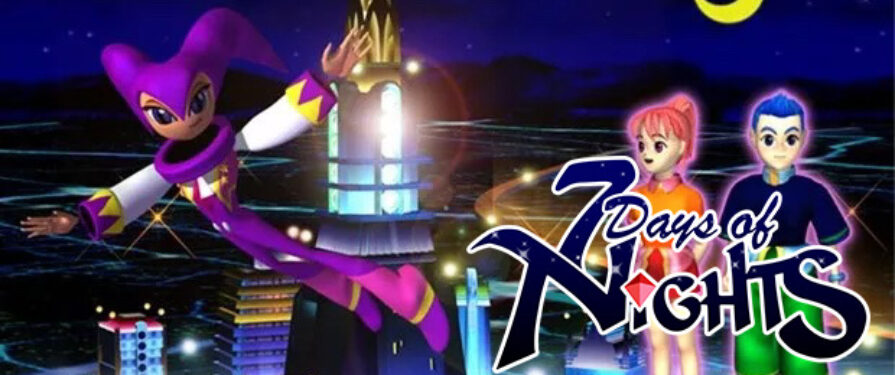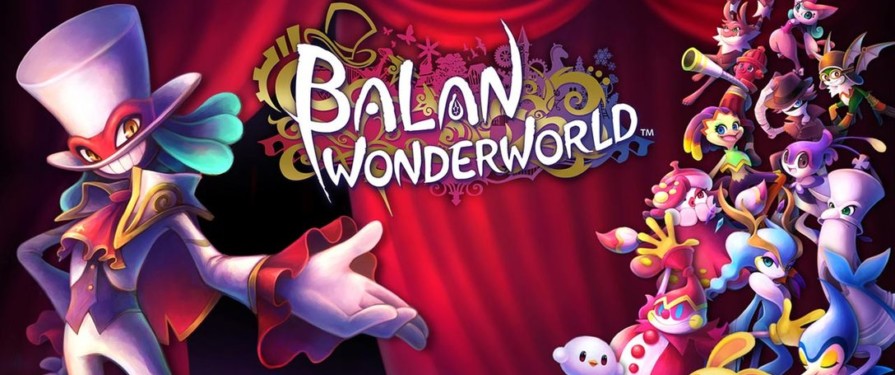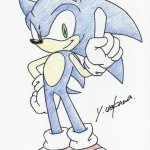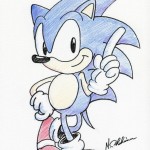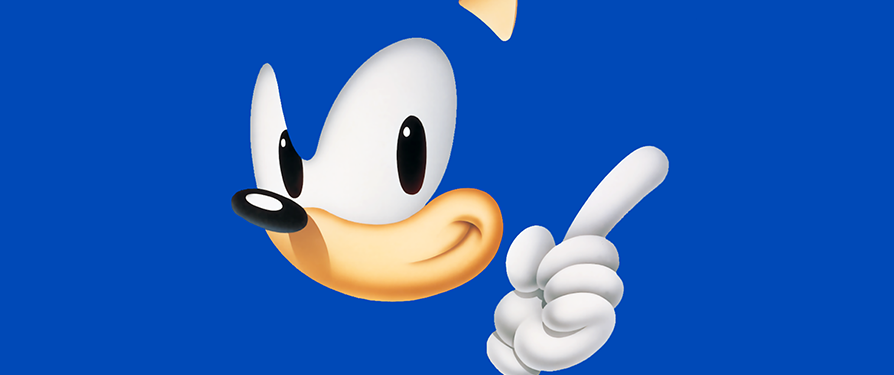The History
It all began on a plane ride.
Yuji Naka was traveling between America and Japan constantly to oversee Sonic the Hedgehog 2’s development. All that time spent in the air made him want to make a game about flight. Though the idea had its roots in 1992, it wouldn’t be until after Sonic & Knuckles’ completion in late 1994 that they were able to begin development for it on SEGA’s newly released SEGA Saturn.
Sonic Team’s primary goal with NiGHTS was to get away from Sonic. They wanted a long break from the character, and desired to create something new that “contradicted” what Sonic was. Early in development, they explored military themes, before eventually setting the game in a dream world.
NiGHTS into Dreams had various influences. Its character design pulled from circus characters, and was inspired by Cirque du Soleil’s “Mystére” show in particular, which Naka saw multiple times during his many trips to America. Sonic Team also did a lot of research into dream studies, as well as the work of psychoanalysts like Sigmund Freud, Carl Jung, and Friedrich Holtz. Jung in particular was an influence, with ideas such as his “dream archetypes” and “animus and anima” becoming central to the game. Jung’s ideas are too large for the scope of this article, but Naka does briefly touch on these elements in an interview with TRiPPY, owner of the fan site nightsintodreams.com.
The Release

NiGHTS into Dreams released in Japan on July 5, 1996, with releases following in the US on August 20 and in Europe on October 7. In the US, its release was accompanied by a $10 million advertising campaign, with the usual ads one might expect from SEGA in the 90s. Many copies of the game were sold with the SEGA Saturn 3D controller, which was developed alongside the game because Sonic Team felt the standard Saturn controller with its digital pad wasn’t accurate enough for the game. Some US copies also came with a free pillow as a pre-order bonus!
Overall, the game was a success, at least by the standards of the SEGA Saturn. It was the system’s best selling game in Japan for 1996, selling 392,000 units. In the US, it was the system’s second best selling game of all time (in terms of dollar sales), second only to Madden ’97. The game was well received by critics, and currently holds an 89% average on GameRankings. It received praise for its visuals, soundtrack, and fluid flight game play, though did receive some criticism for its graphical pop-in and not being “full 3D” like Super Mario 64.
The World
So, we’ve gone over the game’s development and release, but the question remains for anyone unfamiliar with the game: what exactly is NiGHTS? Let’s go over that!
The title character, NiGHTS, is an androgynous being created by the game’s villain, Wizeman the Wicked. Wizeman rules the dimension known as Nightmare. He wishes to destroy Nightopia, the world of dreams, and steal the ideya (human dream energy) of dreamers in order to gather energy and open a portal to the waking world. To carry this out, he created the Nightmarens, with NiGHTS and Reala being his most powerful. But while Reala served dutifully, NiGHTS was mischievous and didn’t like taking orders or agree with Wizeman’s plans, so they rebelled. Wizeman captured NiGHTS, and imprisoned them in a structure called an ideya palace.
Notably, NiGHTS was created specifically by Sonic Team to be genderless, though he/him pronouns have historically been used. The game’s director, Takashi Iizuka, says NiGHTS’ gender is up to the player to interpret, so we’ll be using they/them for this article.
In addition to NIGHTS, the game also stars two children, Claris and Elliot. They’re having nightmares over recent real life fears, and suddenly find themselves in Nightopia, where all their ideya, save for their red ideya of courage, are stolen. This is when they meet NiGHTS, trapped inside the ideya palace. Thanks to the red ideya, which only Claris and Elliot possess, they are able to enter the ideya palace and merge with NiGHTS, freeing them for a limited time. The two children then work with NiGHTS to get their ideya back and defeat the nightmaren boss of each world.
The Game

I’ve seen people call NiGHTS everything from a platformer to a flight game, but anyone going in with those expectations will probably be confused. NIGHTS into Dreams is a essentially a side-scrolling score-attack collectathon. Each level in NiGHTS has four courses (or “mares”), each of which have an ideya to collect from something called an “ideya capture.”
To get the ideya, NiGHTS must collect 20 blue chips, fly into the ideya capture to destroy it, and then bring the ideya back to the ideya palace, which serves as the start and end of each course. Each ideya must be collected within two minutes. If the player runs out of time, NiGHTS is sent back to the ideya palace and the kid must make it back there on their own. If they are caught by the alarm egg, a large floating clock, they get a game over. Once each ideya is collected, NiGHTS then faces the level boss, which also has a two minute timer. To deal with bosses as well as smaller enemies, NiGHTS has two attacks: the drill dash and the paraloop. The drill dash sends NiGHTS drilling into enemies, while the paraloop has NiGHTS flying around an enemy and forming a “loop” with the sparkles that trail them, destroying any smaller enemies caught inside and damaging bosses.
But there’s more to this game than just gathering the ideya and killing enemies. As I said before, NiGHTS is also a score attack game. Doing the bare minimum won’t even be enough to complete the game, since players need a grade of C in all six levels to unlock the seventh level. To do that, one must understand the game’s scoring system.
Nearly everything in this game contributes to player score. Collecting blue chips, flying through rings, killing enemies, and pulling off trick combos after flying through a power ring will all get you points. You can start “links” by linking the collecting of blue chips and rings together, though you have to be fast as links are broken if NiGHTS goes a few seconds without collecting either. Destroying ideya captures quickly also nets NiGHTS a heap of points, though it is after this that the real scoring starts.
To get high scores in this game, players need to lap a course repeatedly after getting the ideya, netting every point possible until the very last second. Run out of time, and players not only lose NiGHTS, but all of their points, typically leaving them with an F grade for the course. This lends the system a certain risk/reward quality. For people like myself, this is where the game really shines.
Alongside all of this, the game also features an “a-life” system, which is essentially a precursor to chao. All of the levels in NiGHTS are populated by friendly Nightopians, who can be interacted with in limited ways. Both NiGHTS and the kids can hatch them from eggs, and NiGHTS can also hurt them with a drill dash or kill them with a paraloop. Obviously, hurting or killing them will make them fearful or angry with NiGHTS. Meanwhile, killing Nightmarens and hatching eggs will make them happy, causing them to reproduce and increase their population. Aside from giving them different behaviors, this system also changes the in-game music, which changes based on their mood. There are also some special kinds of Nightopians.
Nightopian/Nightmaren hybrids called “Mepians” can also be created when Nightmarens are knocked into Nightopians by NiGHTS. This is very hard to do on purpose, so the couple I’ve created over the years (one of which is in the above gallery) were created by accident. These Mepians will also breed, creating other Mepians as well as, eventually, King Pians (pictured above). King Pians appear purely by chance, and will construct a permanent castle within the level once created. They’ll also attack Nightmarens and any Mepians that attack Nightopians. Overall, a fairly complex system for what can effectively just be background creatures!
The Aftermath
After its release, NiGHTS did stick around as a SEGA IP for a time. The franchise received a now-rare line of plushies, which were distributed exclusively in SEGA’s UFO Catchers, as well as a line of keychain plushies. In December of 1996, a NiGHTS story book was published exclusively in Japan, and in late 1997 the game received a six-issue series from Archie Comics featuring art from Patrick Spaziente.
The most notable NiGHTS thing to come in this period, however, was Christmas NiGHTS. Given away for free as a “sampler,” it’s probably one of the most elaborate demo discs ever made. The demo implemented a cut idea from the main game: time activated events. During most of the year, the game is just a vanilla demo of a single level, Spring Valley, but come November 26 it transforms into a Christmas-themed sequel to the original game.
Christmas NiGHTS has narrated opening and closing cutscenes, fully reskins Spring Valley into a Christmas level, introduces brand new courses in that level, and is full of presents that can be unlocked throughout the Christmas season. Everything from playable Sonic to a score attack mode to karaoke can be unlocked, as well as loads of game art and photos of merchandise. Outside of the Christmas season, it also includes winter skins for Claris and Elliot from November through to February, playable Reala on April 1, and other minor differences in the level for certain holidays.
Despite its success, Sonic Team did not immediately begin working on a sequel. Instead, they began work on another game that utilized a more advanced version of the NiGHTS engine: Burning Rangers. After finishing that game, Sonic Team would also begin developing what would eventually become Sonic Adventure. At one point, they did begin work on “Air NiGHTS,” a potential NiGHTS sequel for the Dreamcast that would have utilized motion controls, but nothing ever came of it.
What came next for NiGHTS? Head over to part 2 of this article to find out.

